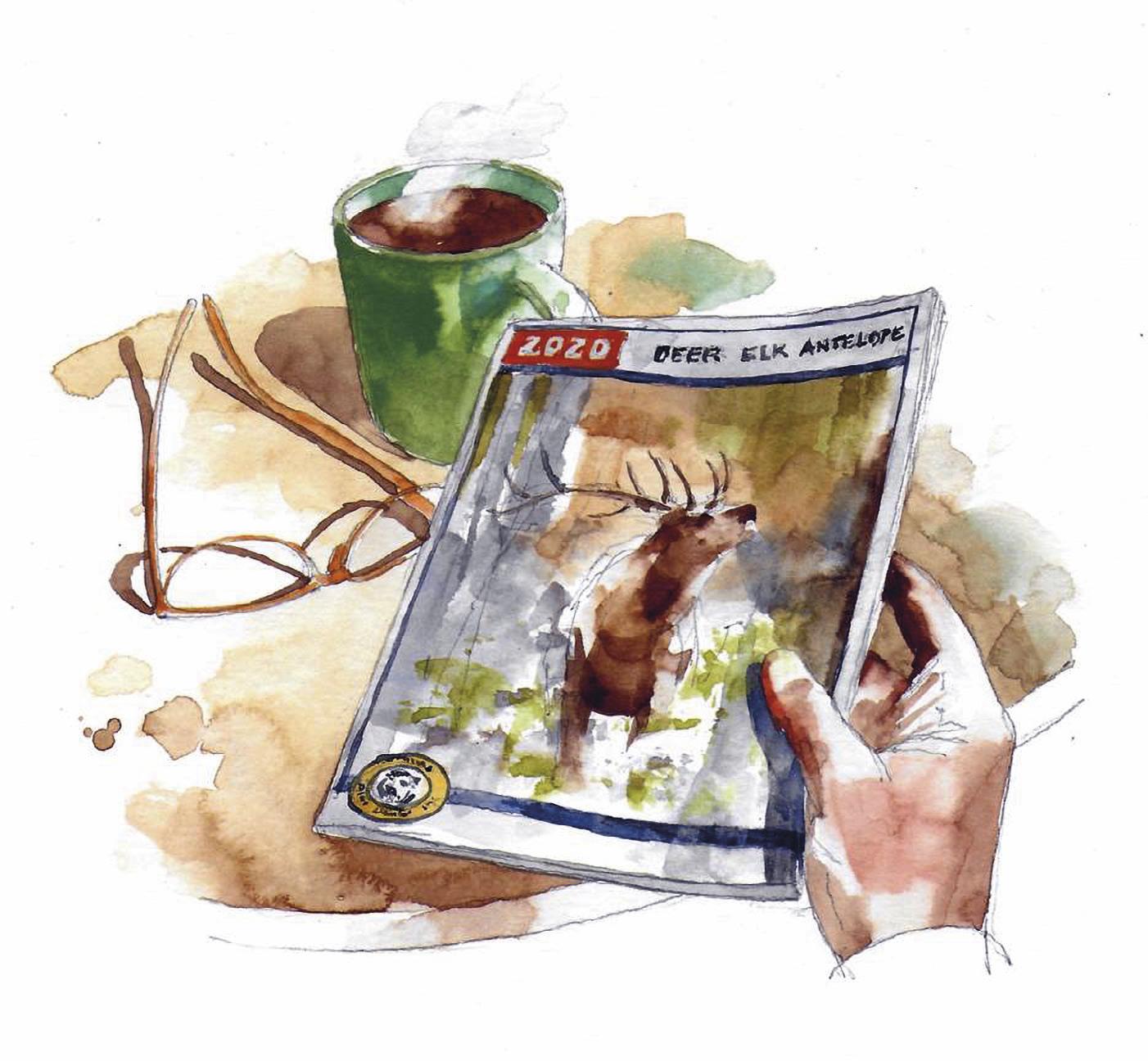SKETCHBOOK
A Handbook of Hunting Opportunities By Tom Dickson
Tom Dickson is the editor of Montana Outdoors.
Another reason for all those pages of hunting districts and permit types is that FWP involves the public when devising hunting regulations. That means accommodating diverse values. For instance, some hunters want more large-antlered deer, which requires FWP to limit hunting permits, while others don’t care much about antlers but want unlimited opportunities to harvest an animal of either sex. The result? More regulations. Then there’s the fact that Montana is home to far more deer, elk, and hunters than there were 50 years ago. The range of our elk, especially, has increased more than 70 percent since the 1960s. That means even more hunting districts requiring customized regulations. Add to that new hunting laws passed during each legislative session. And extra clarifications by FWP legal experts to ensure that charges against poachers, trespassers, and other scofflaws actually stick. All these necessary considerations don’t mean the hunting regulations can’t be improved. A few years ago, an FWP working group of communication specialists, lawyers, and biologists, working with input from hunters, made the booklets more read-
40 | SEPTEMBER-OCTOBER 2020 | FWP.MT.GOV/MTOUTDOORS
able and easier to understand. They cut redundancies, grouped similar items, and put more information into table format to make it easier to read and understand. They also produced a more comprehensive index and moved lengthy hunting district boundary descriptions to a separate booklet. Still, 135 pages? Yikes. Maybe the best way to look at the hunting regulations is as a handbook of Montana’s hunting opportunities, a Cabela’s catalog of all the ways you can pursue and harvest deer, elk, and antelope. For instance, page 15 provides information on the Single-Region Deer B License, which allows hunters to take an additional whitetail in certain regions. Page 16 explains the SuperTag lotteries, which at $5 per chance give hunters a shot at a bighorn sheep, elk, moose, or other big game hunt of a lifetime. Page 17 tells how landowners can obtain preference to harvest an extra doe deer or cow elk on their property. All of page 19 is about youth hunting. Page 20 explains ways that people with disabilities may hunt from a vehicle or use a crossbow. And I’ve still got 115 pages to go. Hunting season is just around the corner. I’d better get back to reading.
ILLUSTRATION BY STAN FELLOWS
M
any resident and nonresident hunters complain to FWP that Montana’s hunting regulations are far too complex. They have a point. The 2020 Deer, Elk, and Antelope regulations booklet alone runs 135 pages. FWP produces additional ones for moose, bighorn sheep, mountain goats, upland birds, waterfowl, wild turkeys, furbearers, and wolves. None of it is what you’d call light reading. Take this sentence: “This prohibition does not apply to a person who is carrying or has physical control over a license or permit issued to that person’s spouse or to any minor when the spouse or minor is hunting with that person.” I recall how, as a newcomer to Montana hunting many years ago, I struggled to make sense of the various numbers, abbreviations, and terms: 007-20, 003-00, BMA, HD, PTHFV, WMA, LPT, OTC, conservation licenses, Single-Region Deer B license, elk permit, elk B license, bonus point, preference points. The list continues. But I’ve since learned that the regulations are dense and complex for good reason. FWP wildlife managers work to ensure as much hunting opportunity as possible, while protecting the health of big game populations and helping cooperating landowners reduce crop loss and other damage by deer and elk herds. That requires managing game populations at an increasingly micro level. Instead of one statewide deer or elk season—which, yes, would be simpler—FWP divides the state into 173 deer and elk hunting districts. Each has its own customized regulations based on factors like carnivore populations, local landowner tolerance for depredation, and the previous year’s harvest and winter severity. The result is far more opportunity and harvest—and far less depredation—than we’d have with a single statewide hunting district and statewide regulations. That might work to adequately manage deer or elk populations in some areas but would end up producing far too many or far too few deer or elk in others.








